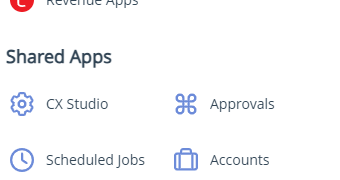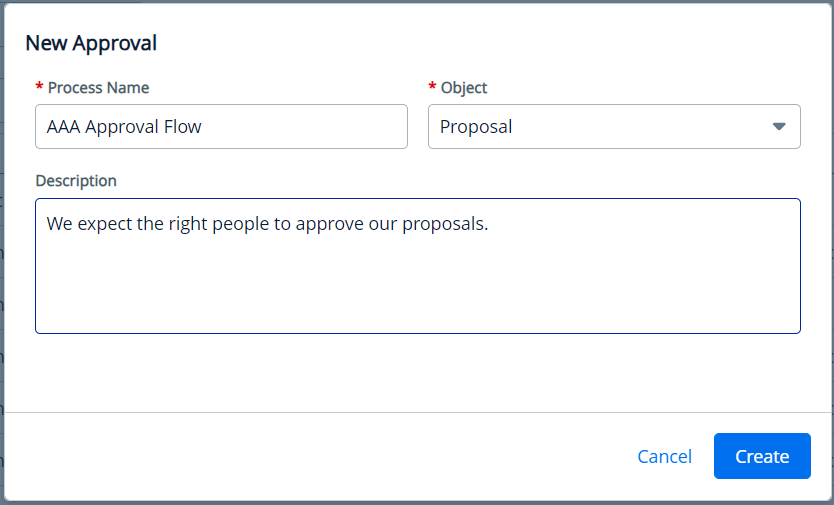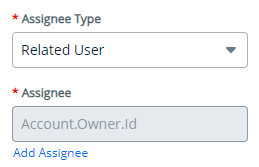Download PDF
Download page Approval Flows.
Approval Flows
The Approval Flows screen orders approval flows for convenient review and maintenance. From this screen you can find and select approval flows for review and create, edit or delete flows. Flows consist of reviewers and rules being applied in a defined order. See Approval Rules for more on these predefined criteria.
To access the Approval Flows window
- Click Shared Apps > Approvals in the left navigation bar:

- If the Approval Flows window does not open by default, click Approval Flows from the left-side menu to open it.
From here, you can create, edit, or delete an approval flow.
To create an approval flow
- Click the Create New button.
- In the New Approval dialog box, enter the process name, the object type (what sort of thing is being approved), and a brief description of the new approval flow.

- Click Create, opening the Approval Flows window to the Setup tab.
- An approval process consists of at least one step, with a person or procedure deciding whether and where the next step, if any, will occur. For each step, click the step box in the Setup window or the plus button in the appropriate location in the Approval Flows Setup window.
- For each step:
- You must name the step: enter a step name in the Step Name field.
- You may describe the step: enter a brief description in the Step Description field.
- You must define the step type: select whether the step is a standard step, a child process, or a sub-process by selecting from the Step Type pull-down menu. When you do this, additional options will appear based on the step type you have selected.
- Selecting the Standard step type raises the required Assignee Type and Assignee fields, and the optional Assignee Description field. You can assign to a user, custom user, related user, or queue. Selecting the Standard step type also offers toggles for: Step Auto Complete, Send Email, Notify Only, Skip Unresolved Assignee, and Step-Level Comments. See Standard-Step Options.
- Selecting the Child Process step type raises the required Context Object and Approver Rule fields. See Child Process Step Options.
- Selecting the Sub Process step type raises the required Approver Rule field. See Sub-Process-Step Options.
- Flip the Step Level Comments toggle to enable reviewers to make comments when they interact with this step in the approval flow.
- You can search user names in the Carbon Copy (cc) field to nominate notification recipients.
- You can shape the flow using the Step Dependencies field to select a dependency that must be fulfilled before a given step can occur. A step dependency is a step that must be completed before the present (dependent) step becomes active. If a flow is established without dependencies, all flow steps occur simultaneously. Using this logic, you can give two different steps a common dependency to make them occur at the same stage (parallel processes) in a flow.
- When you have completed the flow, click Save.
Standard-Step Options
Standard step types have a single approver and cannot use rules.
When you select the standard step type in step 5. c. above, you receive choices in the Assignee Type pull-down for the User, Custom User, Related User, Queue, and Custom Queue assignee types.
| Type | Description | Associated Fields |
|---|---|---|
| User | Assigns the approval request step directly to a user. No logic is employed to discriminate in the assignment. The user identity is fixed and, barring delegation or reassignment, unchanging. | Assignee (required): Username of the assignee responsible for the approval request Assignee Description (optional): Description of the assignee (in this case, an individual, e.g. "Vice President, Sales") |
Custom User | A custom user is a user (or users) selected by reference to logic from a custom object. Custom objects, defined in the Conga Platform, are tables that in this instance link a set of logical tests to a named user or set of users. Each row contains one or more conditions (criteria) and an approver. | Object (required): Pull-down menu for selecting the object associated with the custom user. This set of options is defined in the Conga Platform using a custom object. Record Criteria: When you choose an object, a set of definitions, corresponding to table columns in the custom object, becomes available. Click the Add Criteria hypertext below the Record Criteria field to access the Record Criteria popup. This enables you to enter one or more criteria consisting of Field, Operator, and Value. These can be read as if–then statements. When you are done, the resultant expression is stored in the Record Criteria field. Assignee (required): When the criteria are satisfied, the assignment is sent to the user(s) designated in the custom user defined in the designated custom object field. Assignee Description (optional): Description of the assignee (in this case, an individual, e.g. "Vice President, Sales") |
| Related User | A related user is a user found by reference to a user lookup reference field in the associated business object (e.g., Agreement or Opportunity). This enables you to assign a user associated with the business object (or record) as the approver. For example, you can assign an account's executive sponsor as an approver of that account's quotes. By specifying the executive sponsor via a user field on the account record associated with the quote, you can create a rule or flow where the assignee is held in the executive sponsor field on the account object. | Assignee (required): This field is populated with a related-user definition when you click Add Assignee as described in To add a related user to a flow. Assignee Description (optional): Description of the assignee (in this case, an individual, e.g. "Vice President, Sales") |
| Queue | A queue is a defined group of approvers, any of whom can take ownership of the requested approval and approve or reject it. No logic is employed to discriminate in the assignment. The user identity is fixed and, barring delegation or reassignment, unchanging. | Assignee (required): This pull-down menu enables you to select a predefined queue consisting of one or more reviewers, any of whom can review for the entire group individually. For example, if any member of the Contract Review Committee can approve a transaction, the "CRC" queue is set as the transaction's required reviewer. All committee members receive notification. The matter is resolved when any member of the committee authorizes or rejects the transaction. Assignee Description (optional): Description of the assignee (in this case, a queue, e.g. "Contract Review Committee") |
| Custom Queue | A custom queue is a queue nominated by business logic from a custom object table. | Object (required): Pull-down menu for selecting the object associated with the custom queue. This set of options is defined in the Conga Platform using a custom object. Record Criteria: When you choose an object, a set of definitions, corresponding to table columns in the custom object, becomes available. Click the Add Criteria hypertext below the Record Criteria field to access the Record Criteria popup. This enables you to enter one or more criteria consisting of Field, Operator, and Value. These can be read as if–then statements. Assignee (required): This pull-down menu enables you to select a predefined queue consisting of one or more reviewers, any of whom can review for the entire group individually. For example, if any member of the Contract Review Committee can approve a transaction, the "CRC" queue is set as the transaction's required reviewer. All committee members receive notification. The matter is resolved when any member of the committee authorizes or rejects the transaction. Assignee Description (optional): Description of the assignee (in this case, a queue, e.g. "Contract Review Committee") |
Selecting the standard step type in step 5. c. also raises these options:
- Step Auto Complete: Fill in values for the user when the authorization or review is presented to them.
- Send Email: Notify reviewer of an approval step with a call to action.
- Notify Only: Notify recipient of approval step with no call to action.
- Skip Unresolved Assignee: Allow the approval flow to continue when an assignee cannot be reached.
Child Process-Step Options
Before you can configure a child process, a preconfigured rule must be available for inclusion.
When you select the Child Process step type in step 5. c. above, these options appear:
Context Object. You must choose one of the following from the Context Object pull-down menu:
- Contract: The step pertains to a contract.
- Contract Clause: The step pertains to a contract clause.
- Clause Approval: The step requires a contract clause to be approved.
Approver Rule. You must assign one approver rule. Enter the name of the rule you will apply here. Rule name auto-completion begins when you enter three characters.
Sub-Process-Step Options
Sub-processes require a preconfigured rule to be available for inclusion before you can configure them.
Approver Rule. You must assign one approver rule. Enter the name of the rule you will apply here. Rule name auto-completion begins when you enter three characters.
To add a related user to a flow
Adding related users enables you to configure flows to send items for approval to users or properties identified dynamically, rather than by preconfiguration.
- Follow the steps in To create an approval flow to open the Rule entries tab.
- Click the Setup tab to open the Approval Flows Setup window.
- Click a step entry or one of the plus-sign icons to edit a step, add to an existing step, or add a new step.
- Label, sequence, and describe the rule entry step as needed.
- Select Related User in the Approver Type field. This raises the Add Approver hyperlink below the Approver field.
- Click the Add Approver hypertext to raise an attribute selector. This selector reflects the business object type (Opportunity, Contract, Proposal, Product Configuration, Line Item, Contract Clause, Contract Line Item) chosen in the Approval Flows window for this approval flow.
- Select the parameters that result in the related-user identity you want the flow to identify. For example, to select an account owner by ID to approve a contract type, select Account, Owner, and Id:

This selection is reflected in the bottom legend: "You have selected Account.Owner.Id". - Click Insert. The string entry is added as a related user.

This string is added to requests to the CLM backend to identify documents' account owners dynamically and to route them for approval without laborious fixed definitions. - Complete the flow entry definition as described in To create an approval flow.
Configuring Custom Users and Queues
Custom users and custom queues are objects defined on the Conga Platform. They represent a user or group of users with tabular characteristics in the underlying platform logic. In the Approvals context, they provide the opportunity to present a highly granular definition of the required recipient. For example, one could configure an object that contains a detailed roster of representatives identified by ZIP code ranges, such that a regional representative can be solicited for an approval based on the sales region in which a service will be provided.
To configure a custom user or custom queue, follow the procedure in To create a new custom object.
To edit an approval flow
- Find an approval flow from the Approval Flows window and click the More (kebab) icon
- Select Edit from the pull-down menu, raising the Setup window.
You can edit, add, or delete individual steps in a flow. The steps appear on the screen in entry order until you set dependencies.
- Add steps as described in step 5 of To create an approval flow.
- When a step has been saved and is written to the Approval Flows Setup window, you can further customize it by clicking the More (kebab) menu and selecting from the pull-down menu:

- Add Condition: This applies conditional logic to a step. For example, require this step if permission if an opportunity exceeds a certain threshold; else skip to next step.
- Auto Reapproval: If the assigned reviewer has approved this step once at the present value, their reapproval is assumed and the approval continues. For example, if a sales rep has approved a 50% discount in the past, their approval of a 40% discount on reapproval can be assumed for the current reapproval cycle.
- Reminder Setup: This sets an email reminder at a given point in the approval cycle.
- Escalation Setup: Sets an escalation path and timing. For example, if a sales manager fails to approve a deal after 5 days, escalate to the VP of Sales.
Delete: This deletes the step only.
Note
If all steps are deleted, the approval flow resets from Active to Draft status.
To delete an approval flow
- Find an approval flow from the Approval Flows window and click the More (kebab) icon.
- Select Delete from the pull-down menu.
- Click Delete from the confirmation popup.